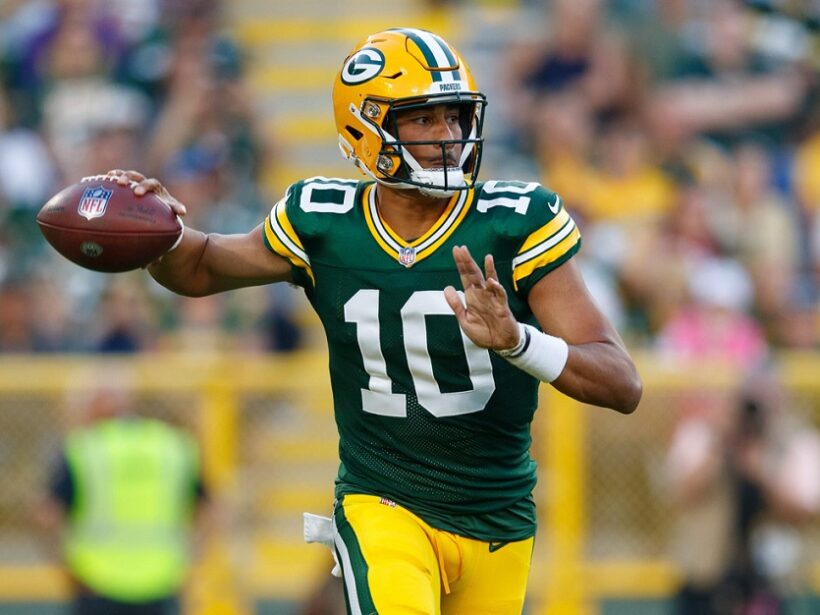The Packers offense will certainly be different next season. Marcedes Lewis is probably gone, Randall Cobb might not stay in the NFL, Allen Lazard signed with the Jets, and, oh yeah, Aaron Rodgers has asked for a trade to the Jets. In a lot of ways, the Packers offense has looked the same for a decade and a half. A lot of outside throws, quick screens on run plays, and letting the play clock run down to almost nothing before snapping the ball. The offense will change in some obvious ways; let’s go over how RPOs, a key part of the offense, and formations could change.
Put the R in RPO
The Packers have been on the forefront of the RPO game since even before Rodgers took over. Brett Favre’s record-setting touchdown pass to Greg Jennings came on one. More recently, Nate Hackett and Luke Getsy, who were college football RPO pioneers, brought the updated version to the team. Unfortunately, Rodgers got a little too into the P portion of RPO at times.
With Rodgers, almost every called run had a pass option based on what he saw pre-snap and he often took that pass option for little or no gain even if a run would almost certainly have been a more productive move. Love will likely be less stubborn than Rodgers and more likely to take the run option when it is warranted, but he also adds the ability to run it himself.
Look back at the Packers-Vikings week 1 game last season. A key turning point of the game was a 4th and goal RPO call where Rodgers didn’t even think about running it in himself (despite that being the read) and Za’Darius Smith easily stopped Aaron Jones for no gain. With Love as a running threat (and he only needs to be a threat to get 5 solid yards every time) two conflict defenders are created.
The end man on the line of scrimmage is optioned off for Love to either keep the ball if he goes toward the RB or give it to the RB if he stays still. Then Love reads a second defender, usually one in the flat. If the second defender lurches toward the designated receiver on the play, Love turns upfield and gets a successful number of yards, if the defender breaks toward Love, he dishes it to the receiver who probably has better YAC ability.
Creating two conflict defenders forces the defense to put more defenders closer to the line of scrimmage – which means they’re further away from Christian Watson and his 4.3-speed running downfield. LaFleur and Love prefer the downfield passing game. I would expect a ton of straight run plays and RPOs designed to open up downfield throwing lanes from Love and his big arm.
More diverse formations and motion
Rodgers made no secret of his disdain for the Shanahan offense which he felt was more gimmicky than the artistry of the west coast offense. Never mind the fact that he hadn’t played on schedule in the west coast offense for about five years.
The backbone of the Shanahan offense is wide zone run play, but what really makes the offense successful is the misdirection of the wide zone play. Play actions, motions, jet sweeps, throwbacks, all kinds of things you can do despite the plays looking identical for the first few seconds. Rodgers wasn’t into those. He preferred to spend as much time as possible reading the defense and figuring out what play to get into to defeat it.
With Love at QB, or really any young player a QB, the offense will rely more on LaFleur’s play calling. LaFleur will be allowed to run his system and use his base plays to set up the defense and his constraint plays to take advantage of them leaning in the wrong direction. A big way he can do this is through formation diversity and motions and shifts.
I think we’ll see a lot of the condensed formations that you see in the Shanahan tree (and tbf, Rodgers seeming always supported these) but also more spread formations designed to get the defense into the types of conflicts described above in the RPO section. Going from an empty spread-out formation with Aaron Jones split out wide to a two or three-tight-end set with AJ Dillon running downhill is hard for any defense.
We should see a lot more motions and shifts. Not only do the motions get linebackers and safeties leaning the wrong direction (you don’t want to be flat-footed when Christian Watson is running away from you) but they help signal to a young QB whether the defense is in man or zone coverage and even what type of zone coverage.
Teams have also started running in the direction of the jet motion and using the motion man as a lead blocker on outside runs. Good luck using your 5’9 190 pound slot corner as the force player when 6‘5 215 pound Christian Watson is coming at him with a running start.
Mike Price is a lifelong Packers fan currently living in Utah. You can follow him on twitter at @themikeprice.
——————


1 response to “How Will the Packers Offense Change With Jordan Love?”